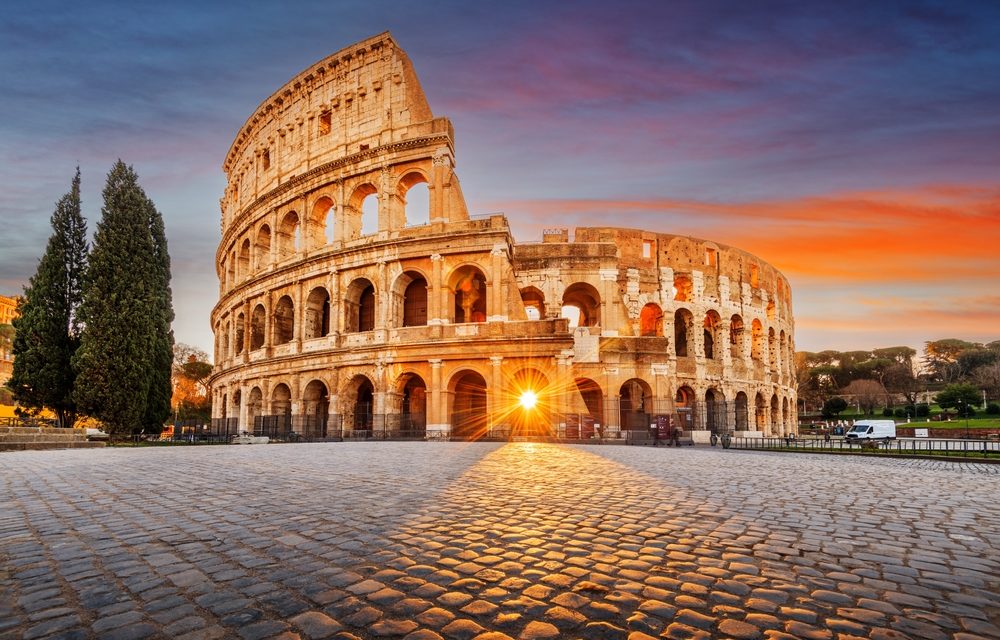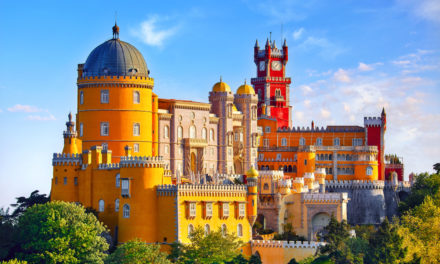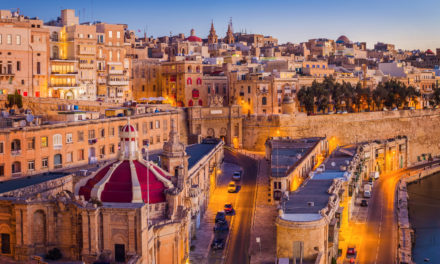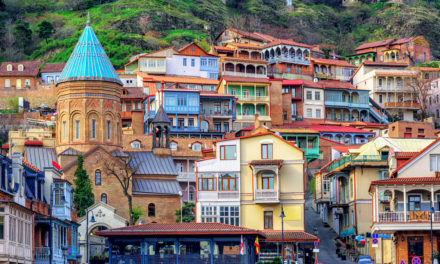Top Tourist Attractions And Things To Do In Europe
Europe, a continent rich in diversity and history, is a testament to human achievement and natural splendor. From the Scottish Highlands’ rolling hills to the Mediterranean’s sun-kissed beaches, its landscapes are as varied as its cultures. Europe’s cities, like Paris and Rome, blend ancient architecture with modern innovation, embodying centuries of artistic, scientific, and political evolution.
The continent has been a crucible for transformative ideas, shaping democracy, philosophy, and the arts. Its extraordinary traditions and languages contribute to a collective identity that respects individuality and fosters a sense of shared heritage. Europe’s story is not just about its past; it’s a continuing narrative of progress and resilience.
Tourist Travel Map of Europe
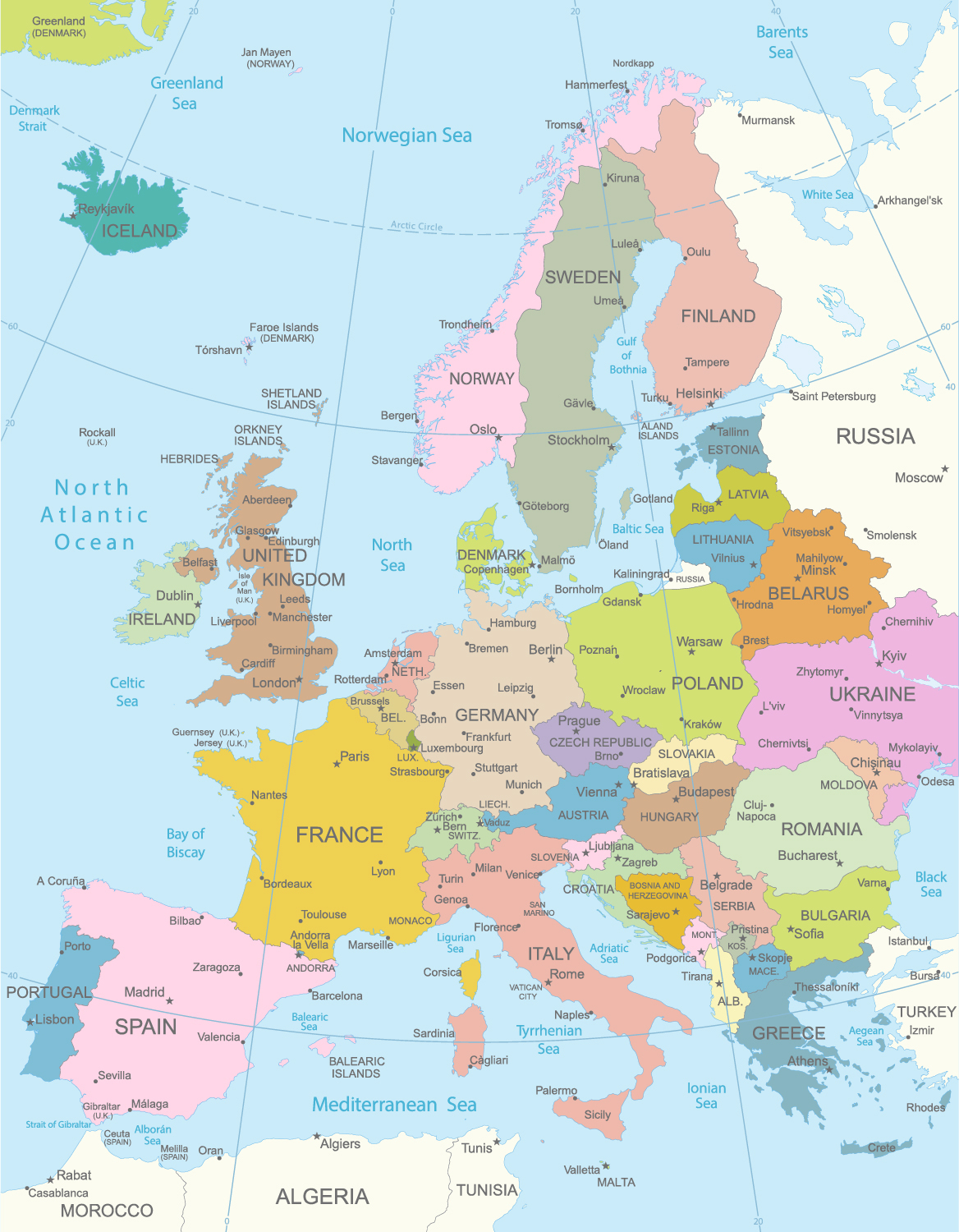

Paris, France:
Paris, the capital city of France, is located in the heart of the Île-de-France region. Renowned for its rich history, iconic architecture, and vibrant culture, Paris is a global center for art, fashion, and gastronomy. This city blends historic sites and modern innovation, making it a must-visit destination in Europe.
Tourist Attractions and Things to Do in Paris, France:
- Eiffel Tower: An emblematic symbol of Paris, the Eiffel Tower offers breathtaking views of the city. Initially built for the 1889 World’s Fair, it is a marvel of engineering and a testament to the city’s artistic heritage.
- Louvre Museum: Home to thousands of works of art, including the Mona Lisa and Venus de Milo, the Louvre is the world’s largest art museum. Its extensive collection spans thousands of years and contains pieces from civilizations around the globe.
- Notre-Dame Cathedral: An icon of French Gothic architecture, Notre-Dame Cathedral is famous for its stunning stained glass windows and intricate sculptures. Despite damage from a recent fire, it remains a symbol of Parisian resilience and history.
- Montmartre: Known for its artistic history, Montmartre is a charming hilltop neighborhood. It was once the hub of modern art in the early 20th century, and today, its quaint streets and lively squares continue to inspire artists and visitors alike.
- Champs-Élysées and Arc de Triomphe: This famous avenue, known for its theatres, cafes, and luxury shops, leads to the Arc de Triomphe. The arch is a monumental architecture commissioned by Napoleon, symbolizing France’s military history.
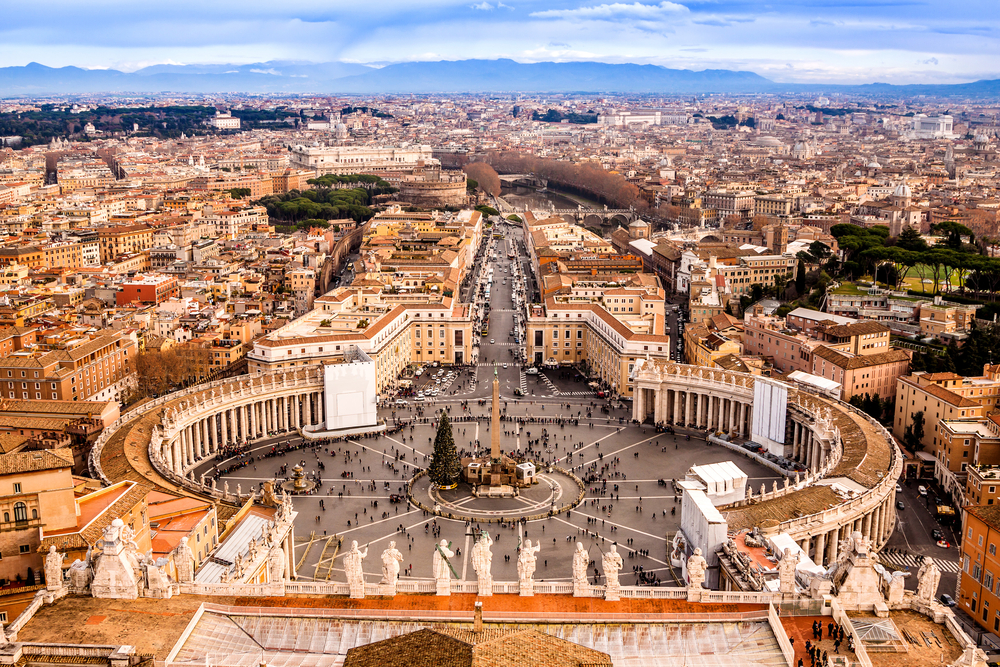
Rome, Italy:
Rome, the capital of Italy, is located in the central-western portion of the Italian Peninsula. Known as the “Eternal City,” Rome boasts a rich history that spans over 28 centuries. As a city that was once the heart of one of the world’s greatest civilizations, it stands today as a testament to the architectural, cultural, and historical prowess of ancient Rome.
Tourist Attractions and Things to Do in Rome, Italy:
- Colosseum: An iconic symbol of Imperial Rome, the Colosseum is an ancient amphitheater that once hosted gladiatorial games and public spectacles. It remains a powerful reminder of Rome’s architectural and engineering skills.
- Vatican City: An independent city-state enclaved within Rome, Vatican City is the spiritual and administrative center of the Roman Catholic Church. It is home to the Pope and a treasure trove of art and architecture, including the Sistine Chapel and St. Peter’s Basilica.
- Roman Forum: Once the center of Roman public life, the Forum houses the ruins of ancient government buildings, temples, and marketplaces. It provides a fascinating glimpse into the daily lives of Romans during the Republic and Empire.
- Trevi Fountain: A masterpiece of Baroque architecture, the Trevi Fountain is one of the most famous and beautiful fountains in the world. Tradition holds that if visitors throw a coin into the fountain, they are ensured a return to Rome.
- Pantheon: Originally a temple to all the Roman gods, the Pantheon is a remarkable building known for its giant dome and oculus. Its architectural design and engineering are so precise that it remains the world’s largest unreinforced concrete dome.
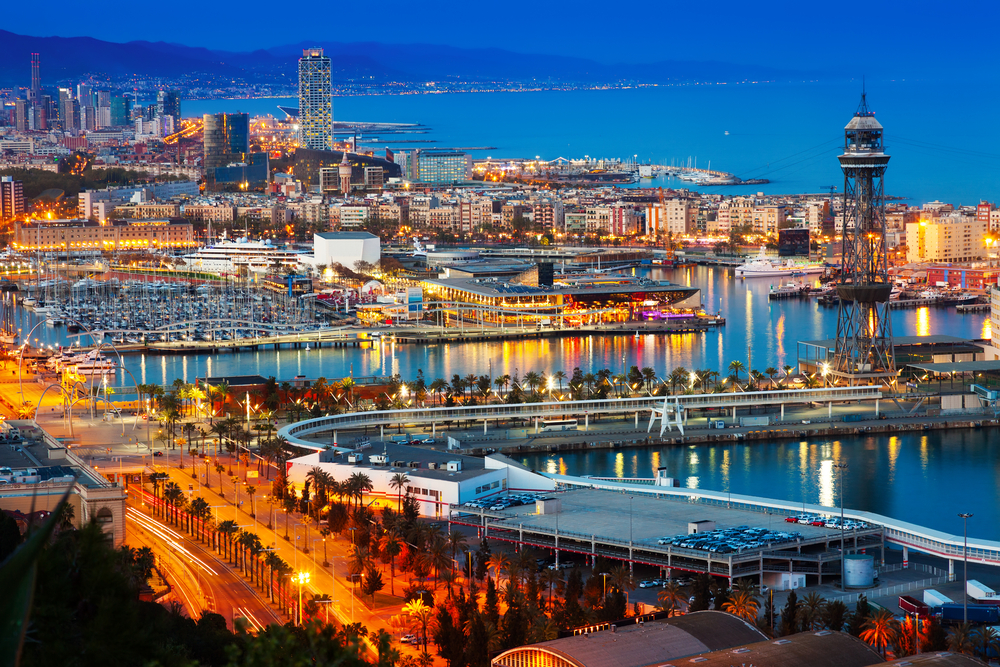
Barcelona, Spain:
Barcelona, the cosmopolitan capital of Spain’s Catalonia region, is known for its art, architecture, and vibrant cultural scene. Situated on the northeastern coast of the Iberian Peninsula, facing the Mediterranean Sea, it’s a city where modernist art movements blend seamlessly with medieval history, creating a unique and dynamic urban landscape.
Tourist Attractions and Things to Do in Barcelona, Spain:
- Sagrada Família: Designed by Antoni Gaudí, this unfinished basilica is a masterpiece of Modernist architecture. Its intricate facades and towering spires make it one of the most unique and visited monuments in the world.
- Park Güell: Another of Gaudí’s creations, Park Güell is a public park filled with gardens, architectural elements, and stunning mosaic works. It offers a fantastic view of the city and is a testament to Gaudí’s imaginative and innovative design style.
- La Rambla: A bustling street in the heart of the city, La Rambla is famous for its lively atmosphere. Lined with shops, cafes, and street performers, it’s a place where tourists and locals alike gather to experience the vibrant energy of Barcelona.
- Gothic Quarter: The center of the old city of Barcelona, the Gothic Quarter is a labyrinth of narrow medieval streets filled with historic buildings, including the Barcelona Cathedral. This area is perfect for experiencing the historical ambiance of the city.
- Picasso Museum: Dedicated to the works of Pablo Picasso, this museum houses one of the most extensive collections of artworks by the 20th-century Spanish artist. It offers a unique look at Picasso’s formative years and his deep connection to Barcelona.
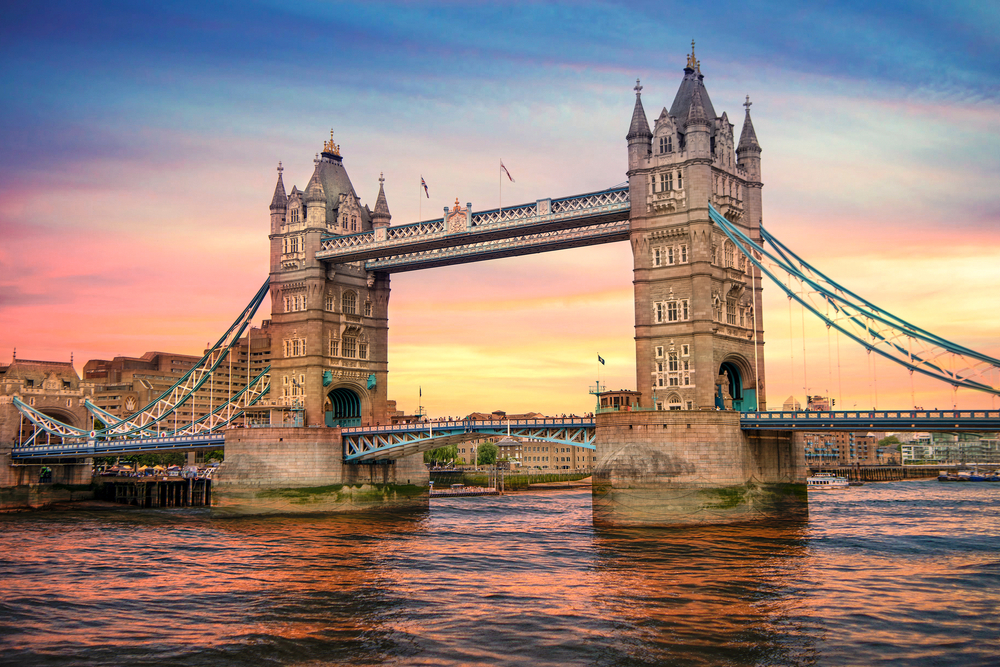
London, United Kingdom:
London, the capital of the United Kingdom, stands on the River Thames in southeastern England. As a leading global city, London is celebrated for its influence in areas like arts, commerce, education, entertainment, fashion, and finance. Rich in history and culture, it is a city where the ancient and modern converge, offering a diverse range of experiences.
Tourist Attractions and Things to Do in London, United Kingdom:
-
The British Museum: Renowned for its expansive collection, the British Museum houses a vast array of world art and artifacts, including the Rosetta Stone and the Parthenon sculptures. It’s a testament to human history and culture.
-
Tower of London: A historic castle on the north bank of the River Thames, the Tower of London is known for its role in British history. From a royal residence to a prison, it now houses the Crown Jewels and offers a deep dive into the country’s past.
-
Buckingham Palace: The administrative headquarters of the Monarch, Buckingham Palace is an icon of British royalty. Visitors can witness the Changing of the Guard ceremony and explore the state rooms during the annual summer opening.
-
London Eye: Offering panoramic views of the city, the London Eye is a giant Ferris wheel on the South Bank of the River Thames. It’s a modern landmark that provides a unique perspective on London’s skyline.
-
Westminster Abbey: A significant structure in British religious and royal history, Westminster Abbey is a stunning Gothic church. It is the site of many royal coronations, weddings, and burials, and is also a UNESCO World Heritage site.
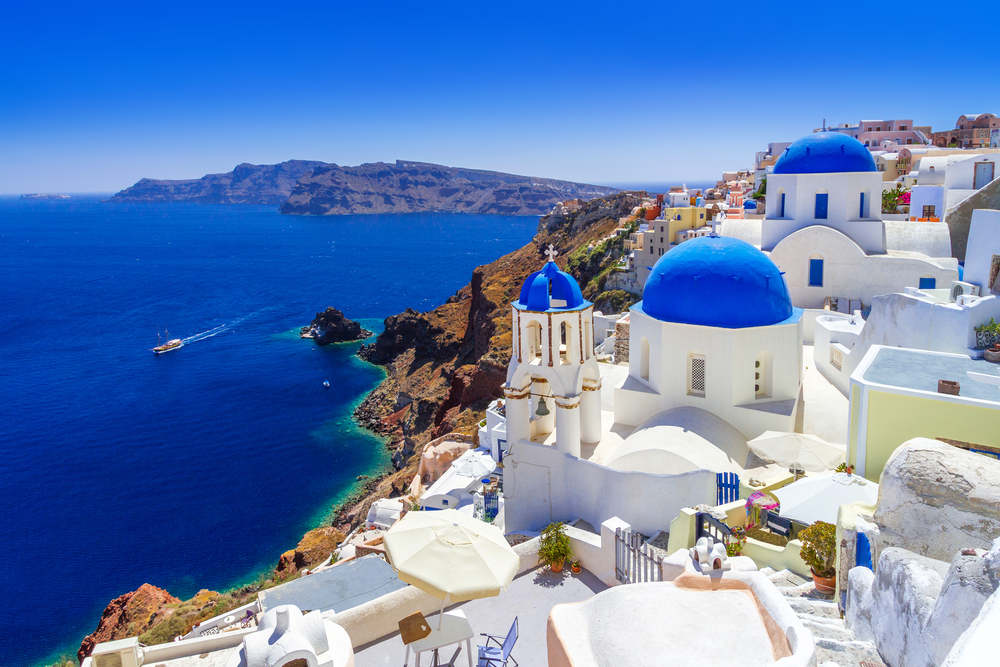
Santorini, Greece:
Santorini, a picturesque island in the Aegean Sea, is one of the most famous islands of Greece. Known for its stunning sunsets, white-washed houses, and blue-domed churches, Santorini is a part of the Cyclades island group. Its dramatic beauty, created by a massive volcanic eruption in the 16th century BC, leaves a lasting impression on its visitors.
Tourist Attractions and Things to Do in Santorini, Greece:
-
Caldera Views: The island’s caldera, a large volcanic crater, offers breathtaking views. The towns of Fira, Oia, Imerovigli, and Firostefani are perched on the cliff edge, providing spectacular vistas of the caldera and the Aegean Sea.
-
Oia Village: Known for its iconic blue-domed churches and sun-bleached houses, Oia is the most photographed location in Santorini. Famous for its stunning sunsets, this village is a must-visit for a quintessential Santorini experience.
-
Ancient Thera: The ruins of Ancient Thera date back to the 9th century BC and offer a glimpse into the island’s past. Situated on a high rocky headland, it provides panoramic views and insights into ancient urban planning.
-
Red Beach: Unique for its striking red volcanic sand and cliffs, Red Beach is a popular spot for swimming and sunbathing. Its unusual color and scenic beauty make it a fascinating destination.
-
Akrotiri Archaeological Site: A well-preserved prehistoric settlement, Akrotiri offers a look into the advanced Minoan civilization. Buried under volcanic ash, which preserved its buildings and frescoes, it’s often referred to as the “Greek Pompeii.”
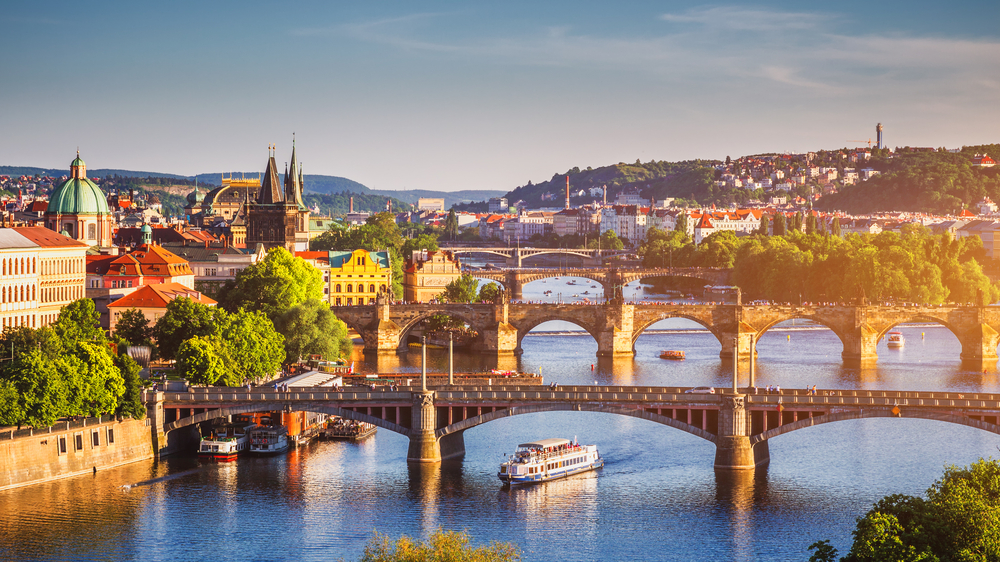
Prague, Czech Republic:
Prague, the capital city of the Czech Republic, is nestled in the heart of Central Europe. Renowned for its unique medieval architecture, the city is often referred to as “the City of a Hundred Spires.” Prague’s rich history, vibrant cultural scene, and picturesque setting on the Vltava River make it a captivating destination for travelers.
Tourist Attractions and Things to Do in Prague, Czech Republic:
-
Prague Castle: This historic castle complex dates back to the 9th century and is a central feature of the city’s skyline. It’s the official office of the President of the Czech Republic and includes palaces, churches, and gardens, offering a deep dive into the country’s history.
-
Charles Bridge: One of Prague’s most famous landmarks, Charles Bridge is a stunning Gothic-style bridge that crosses the Vltava River. Adorned with a continuous alley of 30 statues and statuaries, it offers picturesque views of the city.
-
Old Town Square: The heart of Prague’s historical center, Old Town Square is surrounded by colorful baroque buildings, Gothic churches, and the famous Astronomical Clock, which dates back to the 15th century.
-
Vyšehrad: A historic fort located on a hill overlooking the Vltava River, Vyšehrad contains a basilica, cemetery, and extensive grounds. It’s a place of myth and legend, offering panoramic views of the city.
-
Josefov (Jewish Quarter): This historic area, which was once a Jewish ghetto, is renowned for its well-preserved synagogues, the Jewish Cemetery, and the Jewish Museum. It’s a significant site that reflects the history of Jewish life in Prague.
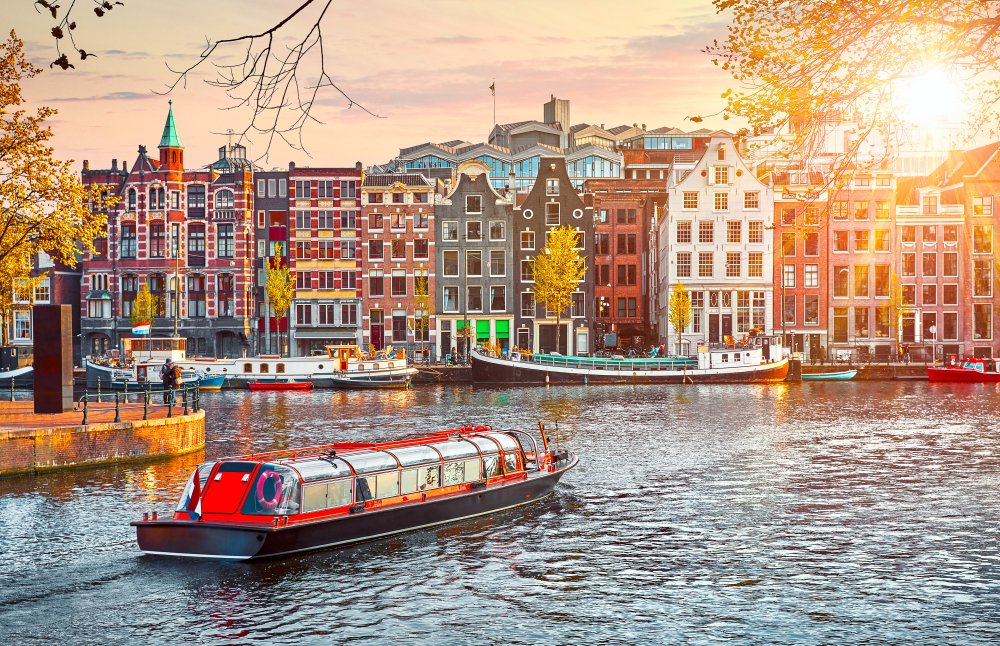
Amsterdam, Netherlands:
Amsterdam, the capital of the Netherlands, is famed for its artistic heritage, elaborate canal system, and narrow houses with gabled facades. Lying in the province of North Holland, this vibrant city is known for its laid-back atmosphere, rich history, and progressive cultural scene. Amsterdam’s blend of historical charm and contemporary urban flair makes it a unique and appealing destination.
Tourist Attractions and Things to Do in Amsterdam, Netherlands:
-
Canals of Amsterdam: The city’s iconic canals, a UNESCO World Heritage site, form a picturesque network of waterways. Exploring these canals, whether by boat or on foot along the cobblestone streets, offers a unique view of Amsterdam’s charming architecture and bustling city life.
-
Van Gogh Museum: Dedicated to the works of Vincent van Gogh, this museum houses the largest collection of his paintings and drawings in the world, including masterpieces like “Sunflowers” and “The Bedroom.” It offers a deep insight into the life and work of the famous artist.
-
Anne Frank House: This museum is dedicated to the Jewish diarist Anne Frank, who hid from Nazi persecution during World War II. The house where Anne and her family hid and where she wrote her renowned diary is now a poignant and powerful reminder of the horrors of war.
-
Rijksmuseum: One of Amsterdam’s most famous museums, the Rijksmuseum showcases Dutch art and history. It features a vast collection that includes masterpieces by Rembrandt, Vermeer, and other Dutch masters, offering a comprehensive look at the richness of Dutch heritage.
-
Vondelpark: The largest and most famous park in Amsterdam, Vondelpark is a green oasis in the heart of the city. Popular with locals and tourists alike, it’s a perfect spot for picnics, outdoor concerts, or just relaxing amidst the lush scenery.
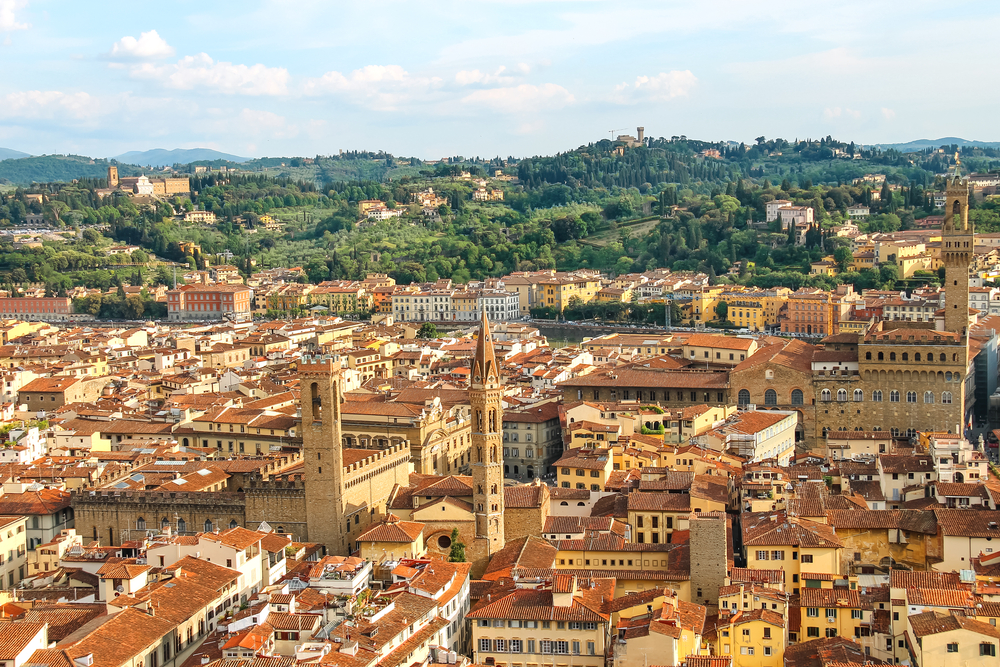
Florence, Italy:
Florence, the capital of Italy’s Tuscany region, is globally celebrated for its profound influence on art, architecture, and culture. Renowned as the birthplace of the Renaissance, this picturesque city is a treasure trove of historic art and architecture. Its rich artistic heritage, combined with its stunning Tuscan setting, makes Florence an essential destination for lovers of art and history.
Tourist Attractions and Things to Do in Flornce, Italy:
-
Uffizi Gallery: One of the world’s most prestigious art galleries, the Uffizi Gallery houses an incomparable collection of Renaissance art. It features works by masters like Botticelli, Michelangelo, and Leonardo da Vinci, offering an unparalleled view of Renaissance artistic achievements.
-
Florence Cathedral (Duomo di Firenze): The city’s most iconic landmark, the Cathedral of Santa Maria del Fiore, with its magnificent red-tiled dome engineered by Brunelleschi, is a marvel of Renaissance architecture. The adjacent bell tower and Baptistery are equally stunning.
-
Ponte Vecchio: A medieval stone bridge spanning the Arno River, the Ponte Vecchio is known for its shops built along it, as was common in medieval cities. It’s a picturesque and historic spot, famous for its jewelry shops and bustling atmosphere.
-
Palazzo Vecchio and Piazza della Signoria: The Palazzo Vecchio, Florence’s town hall, is an impressive fortress-palace. The Piazza della Signoria in front of it is an open-air sculpture gallery, including a replica of Michelangelo’s David and the Fountain of Neptune.
-
Accademia Gallery: Best known for housing Michelangelo’s David, the Accademia Gallery also contains other sculptures by Michelangelo and a collection of Renaissance paintings. It offers insight into the development of Renaissance art and the genius of one of its greatest masters.
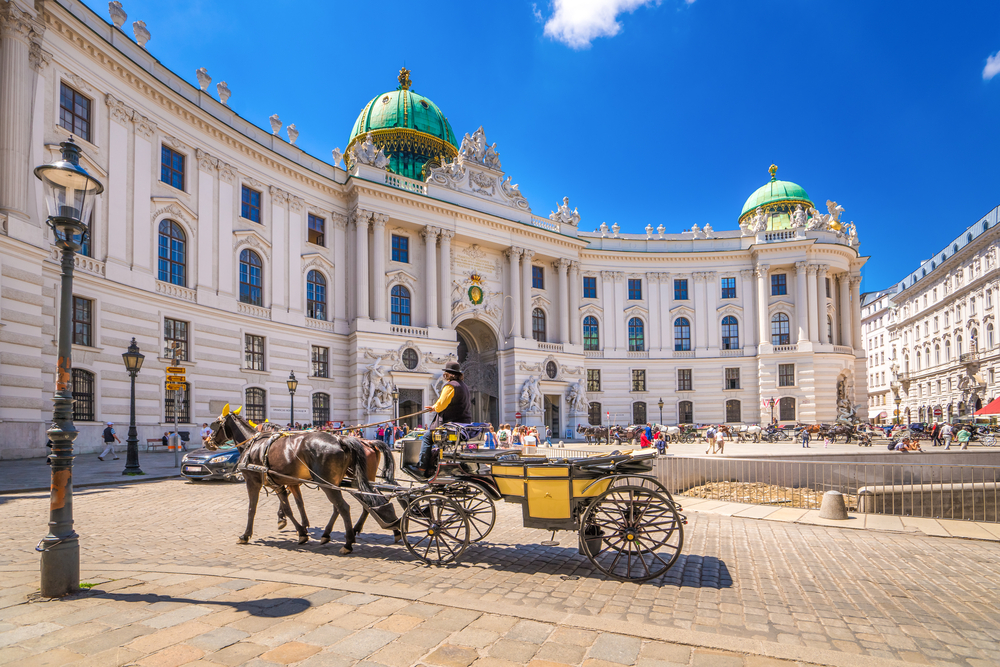
Vienna, Austria:
Vienna, the capital of Austria, is steeped in imperial history, renowned for its classical music heritage, and adorned with grand architecture. Situated in the country’s east on the Danube River, Vienna was the heart of the Habsburg Empire and is now a cultural hub that seamlessly blends its historical past with a vibrant present.
Tourist Attractions and Things to Do in Vienna, Austria:
-
Schönbrunn Palace: A former imperial summer residence, Schönbrunn Palace is one of Vienna’s most important cultural monuments. Its beautifully maintained Baroque architecture, along with its gardens, exemplify the tastes and aspirations of the Habsburg monarchs.
-
Vienna State Opera: Known for its world-class performances, the Vienna State Opera is a cornerstone of Viennese culture. The building itself is an architectural marvel, and attending a performance here offers a quintessential Viennese experience.
-
Belvedere Palace: Comprising two Baroque palaces (the Upper and Lower Belvedere), the Belvedere complex is among Vienna’s most visited historic sites. It houses an extensive collection of Austrian art, including Gustav Klimt’s famous painting, “The Kiss”.
-
Hofburg Imperial Palace: Once the seat of the Habsburg emperors, the Hofburg Palace complex includes various museums and the historic Imperial Apartments. It offers a unique insight into the imperial history of Austria.
-
St. Stephen’s Cathedral: A symbol of Vienna, St. Stephen’s Cathedral (Stephansdom) is a Gothic masterpiece. Its multi-colored tile roof and towering spire dominate the city’s skyline, and the cathedral’s interior is equally impressive with its art and history.
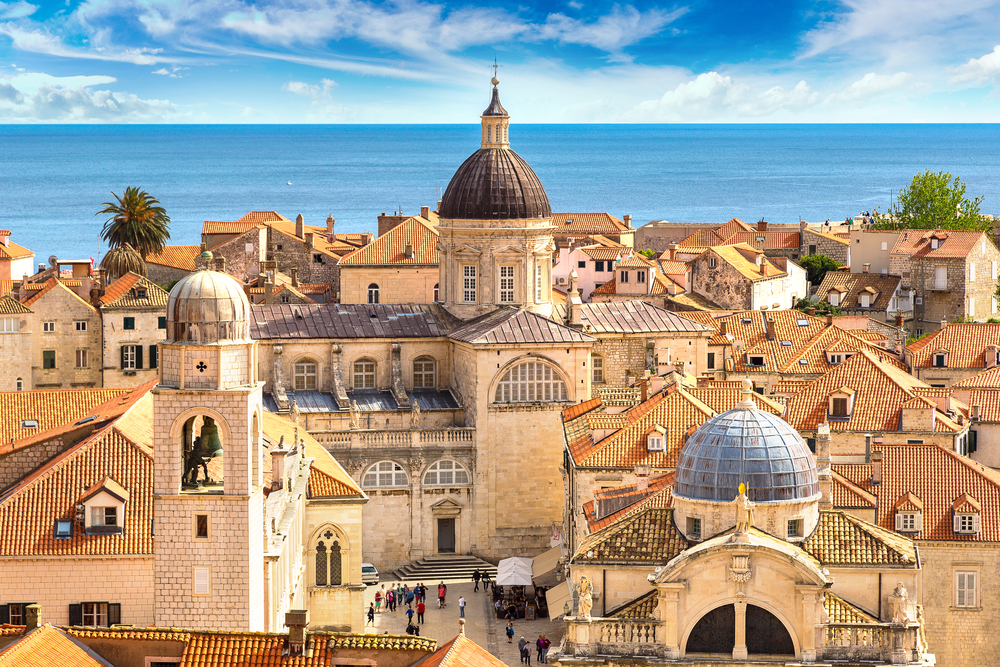
Dubrovinik, Croatia:
Dubrovnik, a stunning coastal city in southern Croatia, is known for its distinctive Old Town, encircled with massive stone walls completed in the 16th century. Its well-preserved buildings and public spaces, steeped in history, are set against the breathtaking backdrop of the Adriatic Sea. Dubrovnik, often referred to as the “Pearl of the Adriatic,” is a fusion of cultural influences and a popular destination for its scenic beauty and historical significance.
Tourist Attractions and Things to Do in Dubrovinik, Croatia:
-
City Walls: The iconic symbol of Dubrovnik, these ancient walls offer spectacular views of the Old Town and the Adriatic Sea. Walking along the walls provides a unique perspective of the city’s layout and architecture.
-
Old Town: A UNESCO World Heritage site, Dubrovnik’s Old Town is a labyrinth of narrow streets and historic buildings. Highlights include the Rector’s Palace, Sponza Palace, and the many churches and monasteries that dot the area.
-
Lovrijenac Fortress: Perched on a cliff outside the western wall of the city, Fort Lovrijenac is an impressive structure with a storied history. It offers panoramic views of the Old Town and the sea, making it a popular spot for sightseeing.
-
Cable Car to Mount Srđ: For breathtaking views of Dubrovnik and the surrounding islands, a cable car ride to the top of Mount Srđ is a must. The summit also hosts a historic fortress and a museum dedicated to the Homeland War.
-
Banje Beach: Situated near the Old Town, Banje Beach is Dubrovnik’s most famous pebble beach, offering stunning views of the city walls and the island of Lokrum. It’s a perfect spot for swimming, sunbathing, and enjoying the Mediterranean ambiance.
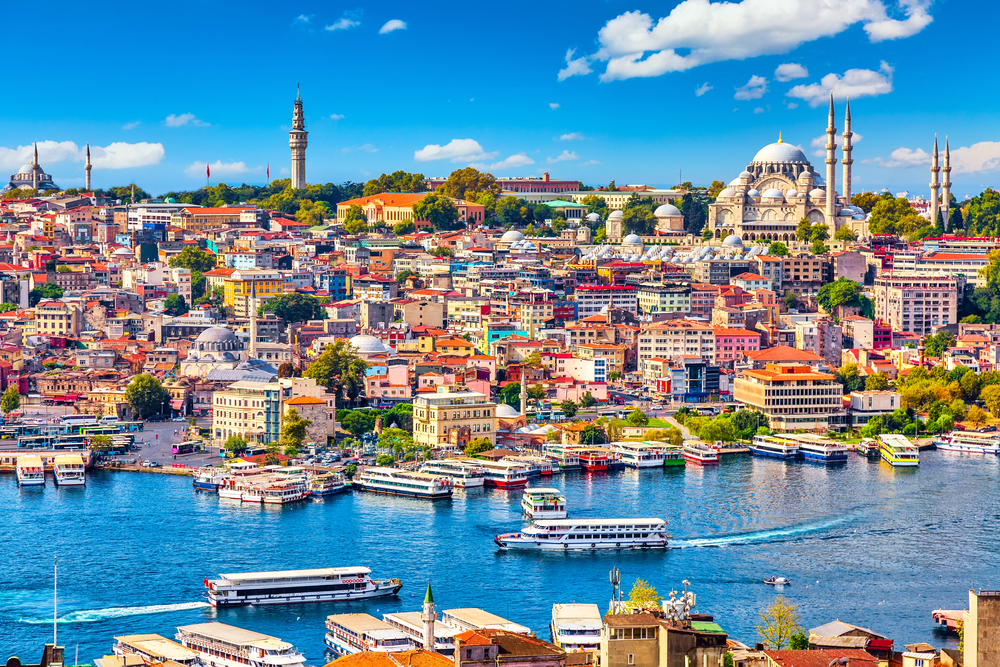
Istanbul, Turkey:
Istanbul, Turkey’s largest city, straddles Europe and Asia across the Bosphorus Strait. Its rich history is reflected in its cultural and architectural wonders, as it served as the capital of the Roman, Byzantine, Latin, and Ottoman Empires. This unique blend of Eastern and Western traditions makes Istanbul a captivating and diverse metropolis.
Tourist Attractions and Things to Do in Istanbul, Turkey:
-
Hagia Sophia: Originally a Byzantine cathedral, later an Ottoman mosque, and now a museum, Hagia Sophia is a symbol of Istanbul’s complex history. Its massive dome and stunning mosaics make it an architectural marvel and a testament to the city’s diverse cultural heritage.
-
Blue Mosque (Sultanahmet Mosque): Famous for its blue tiles adorning its interior walls, the Blue Mosque is an active place of worship and a prime example of Ottoman architecture. Its six minarets and grand scale make it an iconic feature of Istanbul’s skyline.
-
Topkapi Palace: Once the residence and administrative headquarters of the Ottoman sultans, Topkapi Palace is now a museum showcasing imperial collections, including the Prophet Muhammad’s cloak and sword. The palace’s architecture, courtyards, and views of the Bosphorus are impressive.
-
Grand Bazaar: One of the largest and oldest covered markets in the world, the Grand Bazaar is a labyrinth of over 4,000 shops selling a variety of goods, from traditional Turkish crafts to spices and jewelry. It’s a bustling hub of commerce and culture.
-
Bosphorus Cruise: A cruise on the Bosphorus offers a unique way to see Istanbul from a different perspective, highlighting the city’s geography as a bridge between continents. The cruise passes historical sites, opulent palaces, and charming villages along both the European and Asian shores.
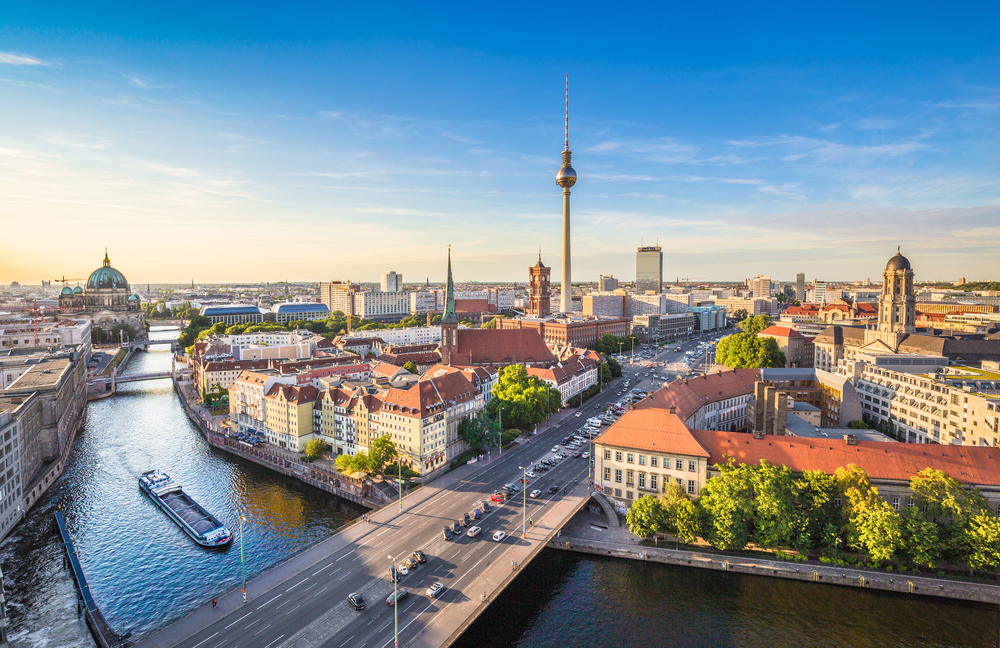
Berlin, Germany:
Berlin, the capital city of Germany, is a vibrant center of history, culture, and art. Known for its significant role in world history, particularly during the 20th century, Berlin offers a unique blend of modernity and history, marked by its iconic landmarks, thriving art scene, and dynamic nightlife. The city’s rich past and its continuous reinvention make it a fascinating destination.
Tourist Attractions and Things to Do in Berlin, Germany:
-
Brandenburg Gate: An iconic symbol of Berlin and German history, the Brandenburg Gate is an 18th-century neoclassical monument. It has witnessed significant historical events and today stands as a symbol of unity and peace.
-
Berlin Wall and East Side Gallery: Once a symbol of division, remnants of the Berlin Wall now serve as a canvas for artists at the East Side Gallery. This open-air gallery showcases murals that reflect on themes of freedom and reconciliation.
-
Reichstag Building: The seat of the German Parliament, the Reichstag is notable for its striking glass dome, which offers panoramic views of the city and a unique perspective on German politics and history.
-
Museum Island: A UNESCO World Heritage site, Museum Island is home to five museums that collectively represent 6,000 years of art and cultural history. Highlights include the Pergamon Museum and the Altes Museum.
-
Memorial to the Murdered Jews of Europe (Holocaust Memorial): This poignant and powerful memorial consists of 2,711 concrete slabs arranged in a grid pattern, symbolizing the scale of the Holocaust tragedy. It’s a solemn and contemplative space dedicated to the victims of the Holocaust.
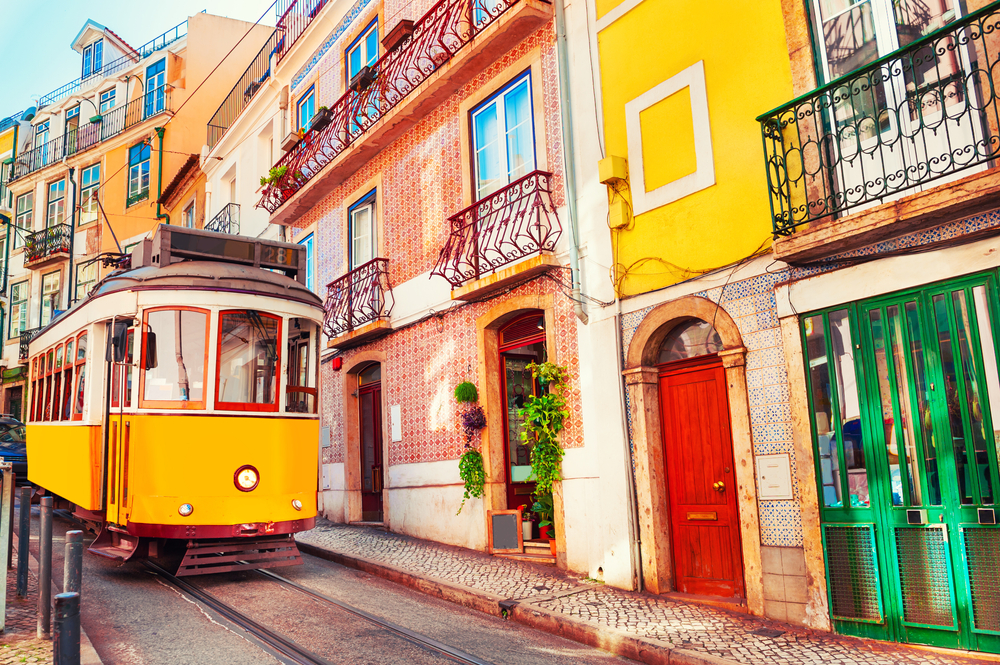
Lisbon, Portugal:
Lisbon, the capital and the largest city of Portugal, is perched on the edge of the Atlantic Ocean. Known for its hilly landscape, historic neighborhoods, and vibrant culture, Lisbon is a city of traditional architecture, contemporary arts, and beautiful vistas. The city’s rich maritime history, ornate architecture, and warm, sunny climate make it an attractive destination for travelers.
Tourist Attractions and Things to Do in Lisbon, Portugal:
-
Belém Tower: A UNESCO World Heritage site, Belém Tower is a symbol of Portugal’s Age of Discoveries. This fortified tower, located on the Tagus River, showcases the ornate Manueline architectural style unique to Portugal.
-
Jerónimos Monastery: Also in the Manueline style, this monastery is a testament to Portugal’s rich maritime history. It was built to commemorate Vasco da Gama’s voyage to India and houses his tomb.
-
Alfama District: The oldest district in Lisbon, Alfama is known for its narrow streets, traditional Fado houses, and beautiful views. This area survived the great 1755 earthquake, making its architecture a fascinating record of Lisbon’s history.
-
Tram 28: Riding the iconic Tram 28 offers a tour through the most picturesque parts of Lisbon, including the Alfama, Baixa, and Graça districts. It’s a charming way to explore the city’s diverse neighborhoods.
-
Praça do Comércio: One of the largest and most majestic squares in Lisbon, Praça do Comércio is situated near the Tagus River. The square is surrounded by yellow Pombaline-style buildings and centered around a statue of King José I, symbolizing Lisbon’s reconstruction after the 1755 earthquake.
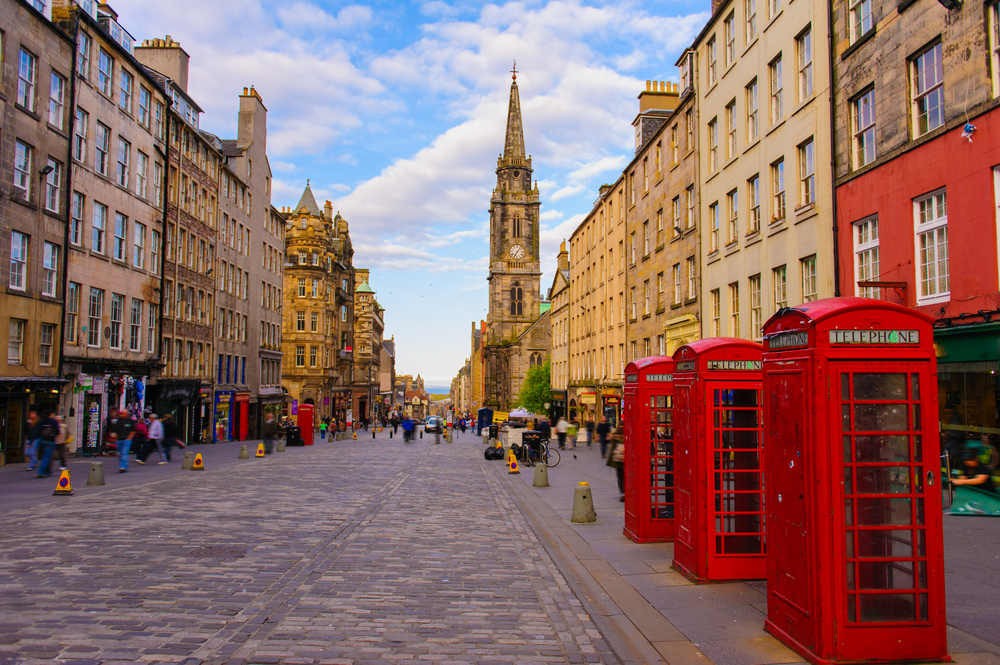
Edinburgh, Scotland:
Edinburgh, Scotland’s capital, is a city that seamlessly blends medieval charm with modern dynamism. Nestled among hills and characterized by its iconic castle, Edinburgh is known for its rich history, cultural festivals, and stunning architecture. Its captivating blend of ancient and contemporary attractions makes Edinburgh a city of contrasts and surprises.
Tourist Attractions and Things to Do in Edinburgh, Scotland:
-
Edinburgh Castle: Perched on an extinct volcanic rock, the castle is a historic fortress that dominates the city’s skyline. It houses the Scottish Crown Jewels and offers a panoramic view of Edinburgh.
-
Royal Mile: Stretching from Edinburgh Castle to the Palace of Holyroodhouse, the Royal Mile is a bustling thoroughfare in the heart of the Old Town, lined with historic buildings, shops, and traditional pubs.
-
Arthur’s Seat: Offering the best views of the city, Arthur’s Seat is an ancient volcano and the main peak in the group of hills in Edinburgh. It’s a popular spot for hiking and enjoying the natural landscape.
-
Palace of Holyroodhouse: The official residence of the British monarch in Scotland, this palace at the end of the Royal Mile is steeped in royal history and boasts beautiful baroque architecture.
-
Scottish National Gallery: Located on The Mound, it showcases a vast collection of fine art, including works from the Renaissance to the post-impressionist period. It’s a cultural gem in the heart of the city.

Budapest, Hungary:
Budapest, Hungary’s capital, is famously bisected by the River Danube. Known for its stunning architecture, thermal baths, and rich history, Budapest is often referred to as the “Paris of the East.” The city’s distinct character, formed by the amalgamation of the once separate cities of Buda and Pest, offers a diverse array of experiences, from historic castles to vibrant nightlife.
Tourist Attractions and Things to Do in Budapest, Hungary:
-
Buda Castle: This historic castle and palace complex of the Hungarian kings in Budapest, on the southern tip of Castle Hill, offers a historical journey along with panoramic views of the city.
-
Parliament Building: An iconic example of Neo-Gothic architecture, the Hungarian Parliament Building is a standout feature on the banks of the Danube. Guided tours offer insights into Hungarian history and the building’s impressive design.
-
Chain Bridge: The first bridge to permanently connect Buda and Pest, the Chain Bridge is an engineering marvel and a symbol of Hungarian advancement. Walking across this bridge offers spectacular views of the river and city.
-
Thermal Baths: Budapest is famous for its thermal baths, such as the Széchenyi and Gellért Baths. These spas, rich in history and architecture, offer a relaxing experience in the midst of the bustling city.
-
Fisherman’s Bastion: Located on Castle Hill, this terrace provides one of the best panoramic views of Budapest, including the Parliament and the Danube. Its fairytale-like towers add to the charm of the city’s skyline.
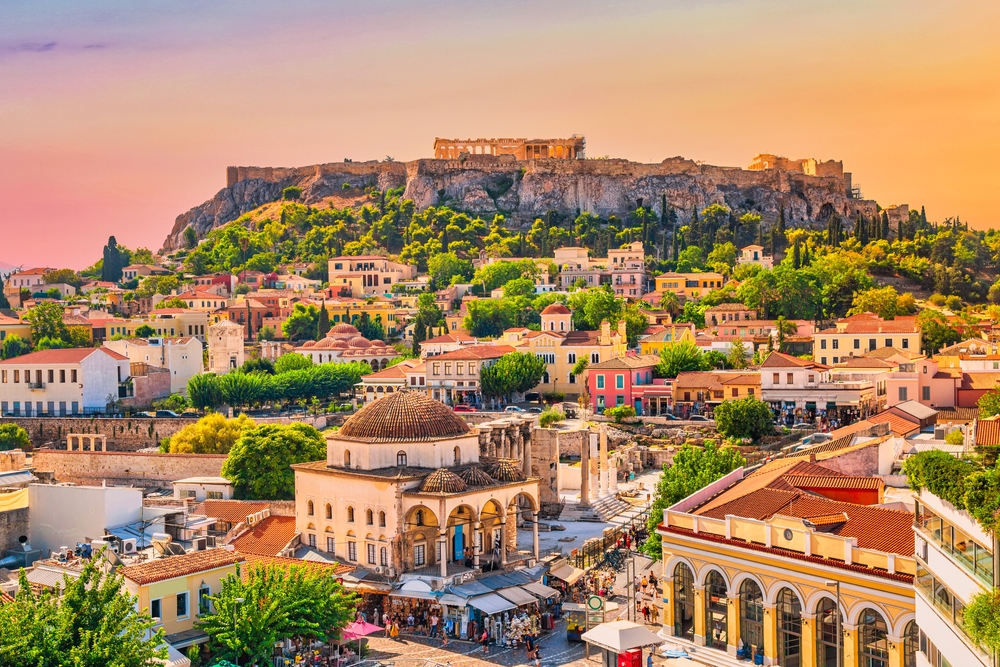
Athens, Greece:
Athens, the capital of Greece, is often regarded as the birthplace of Western civilization. Rich in historical significance, it’s a city where ancient landmarks stand alongside modern urban life. Athens’ blend of classical history, mythological legacy, and contemporary culture creates a vibrant tapestry that attracts visitors from around the world.
Tourist Attractions and Things to Do in Athens, Greece:
-
Acropolis: The Acropolis, an ancient citadel located on a rocky outcrop above the city, is home to several iconic structures, including the Parthenon. It symbolizes the achievements of ancient Greek architecture and culture.
-
Parthenon: This former temple on the Athenian Acropolis is dedicated to the goddess Athena. A masterpiece of Doric architecture, the Parthenon is a globally recognized symbol of ancient Greece’s glory.
-
Plaka: Nestled at the foot of the Acropolis, Plaka is the old historical neighborhood of Athens, known for its labyrinthine streets, neoclassical architecture, and charming cafés and shops.
-
Ancient Agora: The Agora was the heart of ancient Athens, serving as a central gathering place. Today, its ruins provide a fascinating insight into the social and political life of the ancient city.
-
National Archaeological Museum: This museum holds the world’s most comprehensive collection of Greek antiquities, showcasing a vast array of artifacts from all over Greece, spanning from prehistory to late antiquity.
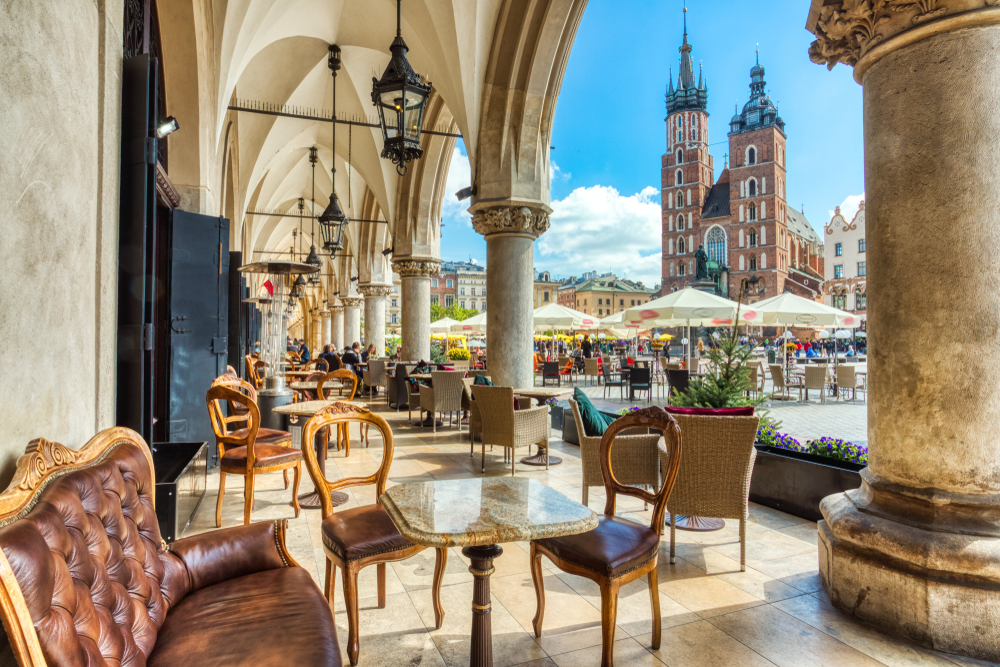
Krakow, Poland:
Krakow, located in southern Poland near the border of the Czech Republic, is one of the country’s oldest and most beautiful cities. Known for its well-preserved medieval core and Jewish quarter, Krakow is steeped in history, culture, and academic tradition. The city’s historical significance, coupled with its vibrant cultural life, makes it a captivating destination.
Tourist Attractions and Things to Do in Krakow, Poland:
-
Wawel Castle: Situated on Wawel Hill, this historic castle has been the residence of Polish kings and a symbol of Polish statehood. It’s a key cultural and architectural complex, showcasing various architectural styles.
-
Main Market Square (Rynek Główny): As Europe’s largest medieval town square, it’s the bustling heart of Krakow. The square is surrounded by historic buildings, cafes, and shops, and features the Cloth Hall and St. Mary’s Basilica.
-
Kazimierz (Jewish Quarter): Once a separate town, Kazimierz is known for its historical Jewish culture. It’s filled with synagogues, charming cafes, and art galleries, reflecting a rich cultural tapestry.
-
Wieliczka Salt Mine: A bit outside Krakow, this UNESCO World Heritage site is famous for its deep underground mines, beautiful salt carvings, and chapels carved out of rock salt by miners.
-
Auschwitz-Birkenau Memorial and Museum: Located near Krakow, this former Nazi concentration and extermination camp is a somber reminder of the horrors of the Holocaust. It’s a place of remembrance and education about the tragedies of World War II.

Stockholm, Sweden:
Stockholm, the capital of Sweden, is an archipelagic city known for its stunning beauty, innovative design, and a high standard of living. Spread across 14 islands where Lake Mälaren flows into the Baltic Sea, Stockholm combines modern urbanity with historical charm, surrounded by waterways and green spaces.
Tourist Attractions and Things to Do in Stockholm, Sweden:
-
Gamla Stan (Old Town): The historical heart of Stockholm, Gamla Stan is known for its well-preserved medieval street layout. Its narrow, winding cobblestone streets are home to the Stockholm Cathedral, the Nobel Museum, and the Royal Palace.
-
Vasa Museum: This maritime museum on Djurgården Island houses the Vasa, a 17th-century ship that famously sank on its maiden voyage and was later salvaged. It’s a unique window into maritime history and technology of the era.
-
Skansen Open-Air Museum: The world’s first open-air museum, Skansen showcases traditional Swedish living, including historical buildings and demonstrations of crafts from various regions of Sweden.
-
Archipelago: The Stockholm archipelago, with thousands of islands, is a natural wonder. Accessible by boat tours, it offers activities like kayaking, hiking, and swimming, making it a perfect escape into nature.
-
ABBA The Museum: An interactive exhibition dedicated to the famous pop group ABBA, this museum offers a fun and engaging look at the band’s history, including their music, costumes, and cultural impact.
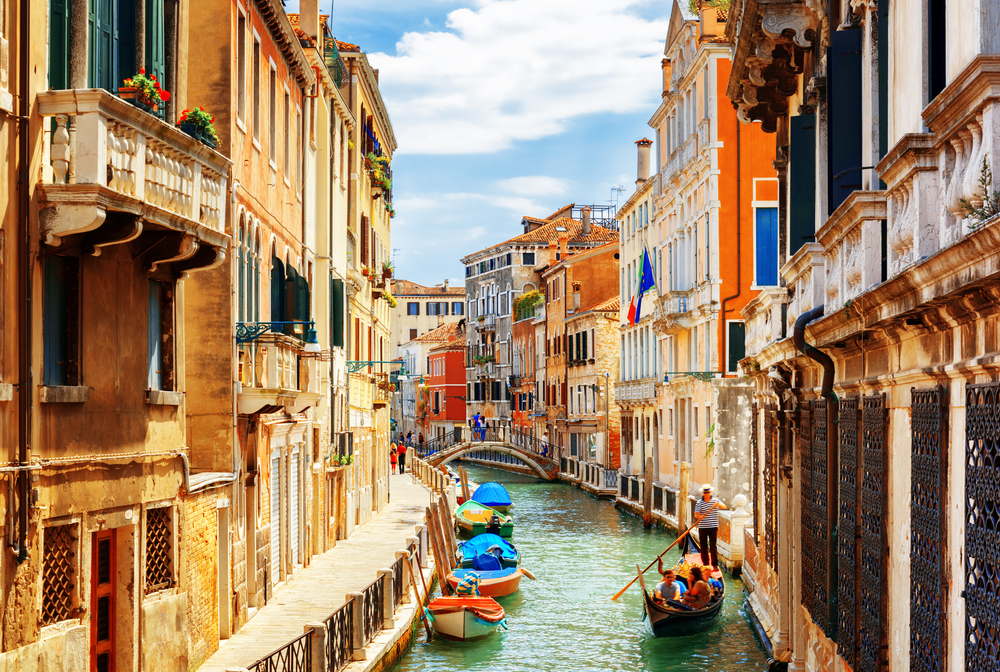
Venice, Italy:
Venice, often known as “La Serenissima,” is a unique city in northeastern Italy, famed for its beautiful canals, architectural marvels, and rich historical heritage. Built on 118 small islands linked by a network of canals and bridges, Venice is an enchanting city that seems suspended in time, blending elements of art, history, and romance.
Tourist Attractions and Things to Do in Venice, Italy:
-
Grand Canal: The main waterway of Venice, the Grand Canal, is lined with palatial Renaissance and Gothic palaces. A gondola ride or a trip on a vaporetto (water bus) along this canal offers a picturesque view of the city’s heart.
-
St. Mark’s Basilica: This opulent church is one of the finest examples of Byzantine architecture. Its ornate details, gold mosaics, and symbolic artworks contribute to its reputation as a symbol of Venetian wealth and power.
-
Doge’s Palace (Palazzo Ducale): A masterpiece of Gothic architecture, the Doge’s Palace was the residence of the Doge of Venice, the supreme authority of the former Venetian Republic. It houses a museum and offers insights into Venice’s glorious past.
-
Rialto Bridge: One of the most famous and oldest bridges spanning the Grand Canal, the Rialto Bridge’s current structure, a beautiful example of Renaissance architecture, was completed in 1591.
-
Venetian Ghetto: The world’s first ghetto, established in 1516, is a significant historical area. It was once the designated area for Jewish residents, and today it’s a center of Jewish life and culture in Venice.
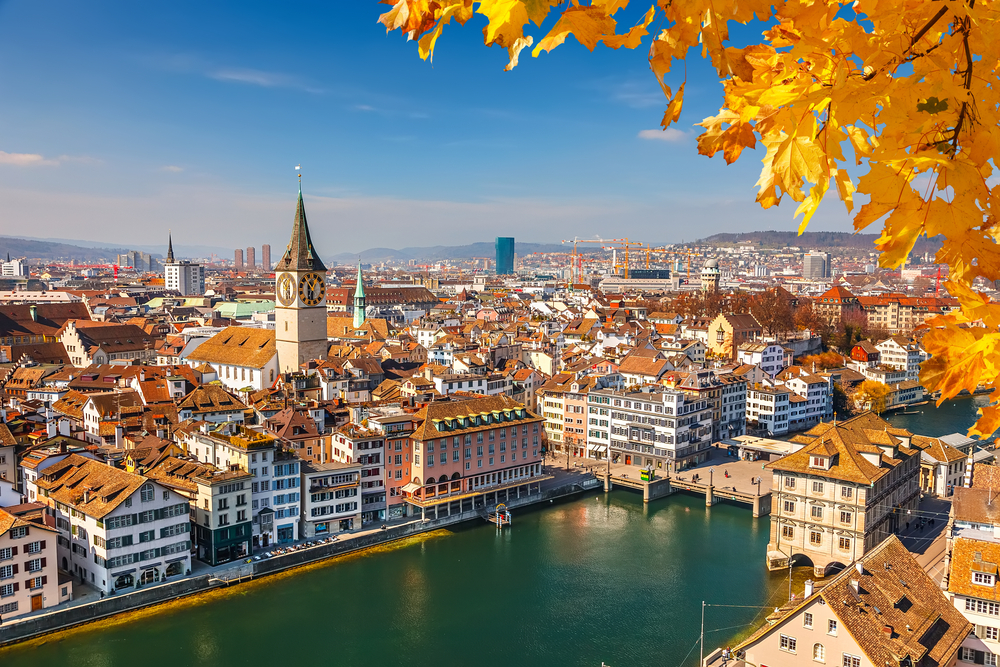
Zurich, Switzerland:
Zurich, Switzerland’s largest city, is known for its well-preserved medieval Old Town, vibrant cultural scene, and as a global center for banking and finance. Nestled at the meeting of river and lake, Zurich’s mix of natural beauty and urban sophistication makes it a unique and appealing destination.
Tourist Attractions and Things to Do in Zurich, Switzerland:
-
Lake Zurich: The focal point of the city, Lake Zurich is surrounded by parks and promenades. It offers opportunities for boating, swimming, and picnicking, providing a serene escape in the city.
-
Old Town (Altstadt): The historical center of Zurich, with its winding alleys and ancient buildings, tells the story of the city’s past. Notable landmarks include Grossmünster Church and the medieval Rathaus (Town Hall).
-
Bahnhofstrasse: One of the world’s most exclusive shopping streets, Bahnhofstrasse is known for its luxury boutiques, department stores, and street cafes. It’s a bustling avenue that reflects Zurich’s cosmopolitan character.
-
Swiss National Museum: Housed in a fairy-tale castle, the museum offers a comprehensive collection of historical artifacts that showcase Swiss cultural history, including folk art, furniture, and ancient armor.
-
Uetliberg Mountain: Offering panoramic views of the entire city of Zurich and the Lake Zurich, Uetliberg Mountain is a popular spot for hiking and biking. The summit is easily accessible by train, making it a favorite amongst both locals and tourists.
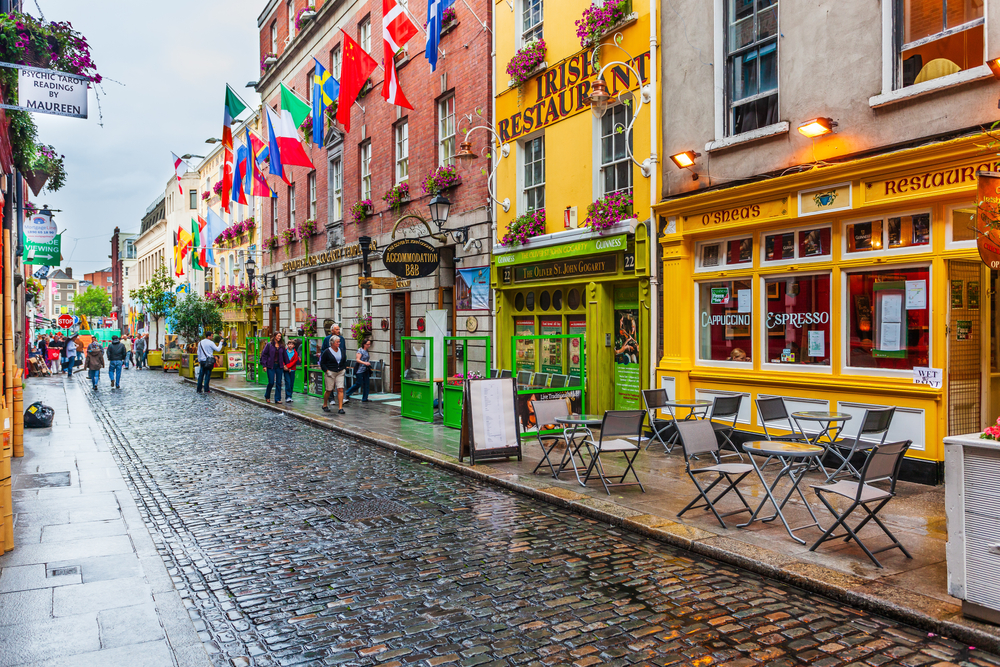
Dublin, Ireland:
Dublin, the capital of Ireland, is renowned for its literary heritage, vibrant nightlife, and rich history. Located at the mouth of the River Liffey, this city seamlessly blends historical landmarks with a lively contemporary culture, making it a dynamic and welcoming destination.
Tourist Attractions and Things to Do in Dublin, Ireland:
-
Trinity College and the Book of Kells: Ireland’s oldest university, Trinity College, is home to the Book of Kells, a beautifully illuminated manuscript created by Celtic monks around 800 AD. The campus itself is a blend of historic and modern architecture.
-
Guinness Storehouse: The home of the famous Guinness beer offers a tour that leads to the Gravity Bar, where visitors can enjoy a pint of Guinness with a panoramic view of the city.
-
Temple Bar: Known for its vibrant nightlife, cobbled streets, and cultural events, Temple Bar is a bustling area filled with pubs, galleries, restaurants, and music venues, offering a taste of Dublin’s modern cultural scene.
-
Dublin Castle: Dating back to the 13th century, Dublin Castle has played a significant role in Irish history. Today, it’s a major Irish government complex and a venue for state functions and conferences.
-
Kilmainham Gaol: A former prison, now a museum, Kilmainham Gaol played a key role in Irish history, particularly in the struggle for Irish independence. Guided tours provide a poignant insight into this turbulent chapter of Ireland’s past.
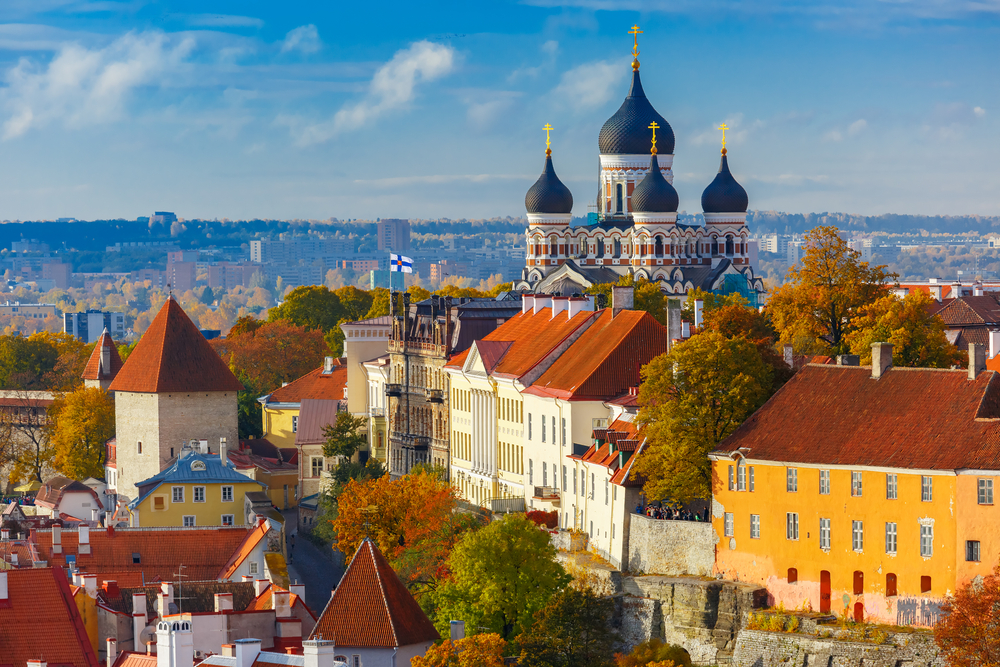
Tallinn, Estonia:
Tallinn, the capital of Estonia, is distinguished by its well-preserved medieval architecture and its status as a modern technology hub. Situated on the Baltic Sea, Tallinn’s Old Town is a UNESCO World Heritage site, while the city itself is known for its digital advancements and vibrant cultural scene.
Tourist Attractions and Things to Do in Tallin, Estonia:
-
Old Town: Tallinn’s historic center is famous for its preserved medieval buildings, cobblestone streets, and the 15th-century defensive wall. This area is home to many of the city’s landmarks, including Toompea Castle and Alexander Nevsky Cathedral.
-
Toompea Hill: Offering panoramic views of the city, Toompea Hill is a limestone plateau in the central part of the Old Town. It’s home to Toompea Castle, the Estonian Parliament, and the stunning Russian Orthodox Alexander Nevsky Cathedral.
-
Kadriorg Palace and Park: Built by Peter the Great for his wife, Catherine I of Russia, Kadriorg Palace is now an art museum set in a beautiful park. The park also houses the Kumu Art Museum, showcasing Estonian art.
-
Seaplane Harbour (Lennusadam): This maritime museum in a former seaplane hangar has interactive exhibits including a submarine, seaplanes, and icebreaker ships, making it an exciting visit for all ages.
-
Tallinn TV Tower: The tallest building in Estonia, the Tallinn TV Tower provides an excellent vantage point for views over the city and beyond. It also features exhibits and a restaurant.
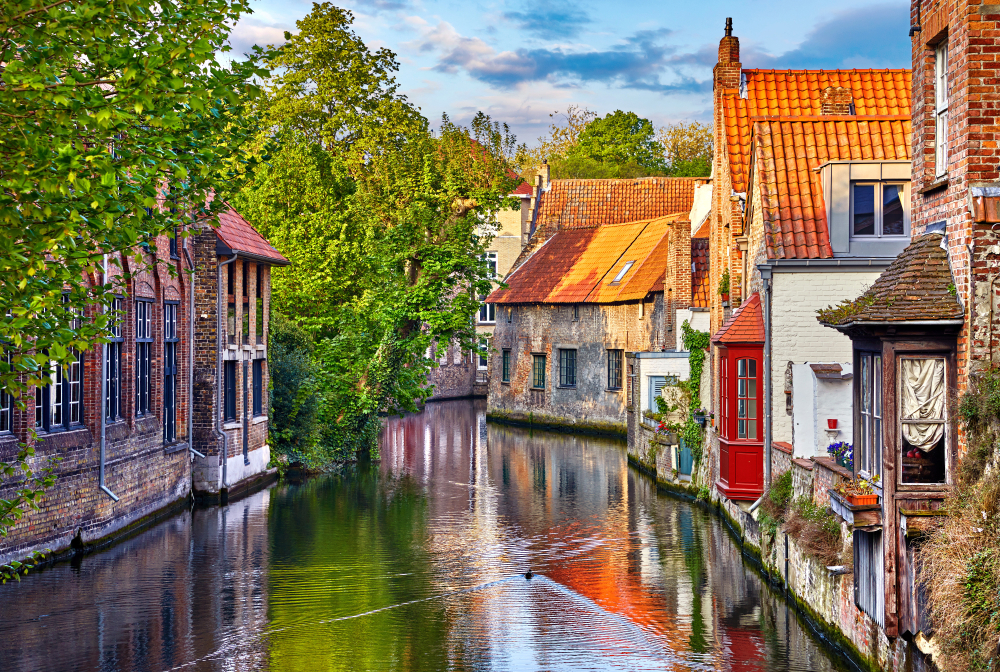
Bruges, Belgium:
Bruges, often referred to as the “Venice of the North,” is a charming city in Belgium known for its well-preserved medieval architecture, picturesque canals, and cobblestone streets. This fairy-tale-like city in the Flemish Region of Belgium captivates with its romantic ambiance, rich history, and cultural offerings.
Tourist Attractions and Things to Do in Bruges, Belgium:
-
Belfry of Bruges: This iconic medieval bell tower in the market square offers panoramic views of the city. Climbing its 366 steps leads to a breathtaking vista and a close-up view of the carillon’s 47 melodious bells.
-
Canal Tours: Exploring Bruges by boat provides a unique perspective of the city. The canals, flanked by historic buildings and charming bridges, offer a serene and picturesque tour of this medieval city.
-
Market Square (Markt): The bustling heart of Bruges, Markt is surrounded by historic guildhalls and lively cafes. The square is a great starting point for exploring the city and experiencing its vibrant atmosphere.
-
Basilica of the Holy Blood: This beautiful church houses a revered relic: a vial said to contain a drop of Christ’s blood. The basilica’s architecture is a mix of Romanesque and Gothic styles, making it a notable landmark.
-
Groeningemuseum: This museum boasts an impressive collection of Flemish and Belgian paintings, including works by Jan van Eyck and other Flemish Primitives. It provides a deep insight into the region’s rich artistic heritage.
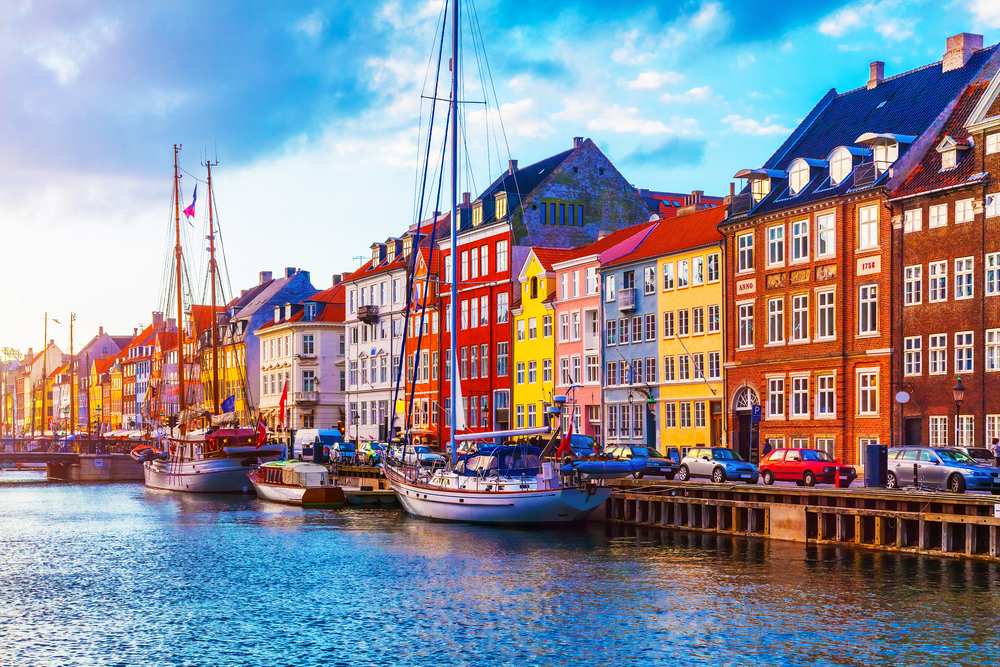
Copenhagen, Denmark:
Copenhagen, the capital of Denmark, is a city known for its vibrant culture, historical landmarks, and modern design. Situated on the eastern coast of the island of Zealand, it features picturesque canals, cobbled squares, and a blend of ancient and contemporary architecture, reflecting its rich maritime history and progressive ethos.
Tourist Attractions and Things to Do in Copenhagen, Denmark:
-
Tivoli Gardens: One of the oldest operating amusement parks in the world, Tivoli Gardens offers a magical blend of rides, games, musicals, ballet, and major concerts. Its beautifully landscaped gardens and evening lights create a fairy-tale atmosphere.
-
Nyhavn: Famous for its brightly colored 17th and early 18th-century townhouses, Nyhavn is a historic waterfront and canal district. It’s a popular area with bars, cafes, and boats, reflecting the city’s maritime history.
-
The Little Mermaid Statue: Inspired by Hans Christian Andersen’s fairy tale, this iconic bronze statue sits on a rock in the harbor. Despite its small size, it’s one of Copenhagen’s most famous tourist attractions.
-
Christiansborg Palace: Located on the islet of Slotsholmen, Christiansborg Palace houses the Danish Parliament, the Supreme Court, and the Ministry of State. Parts of the palace are used by the Royal Family for various functions and events.
-
Rosenborg Castle: Built in the early 17th century, Rosenborg Castle is a renaissance castle that houses some of Denmark’s greatest cultural treasures, including the Crown Jewels and the Danish Crown Regalia.

